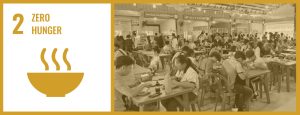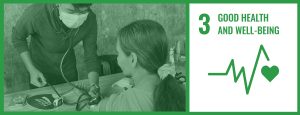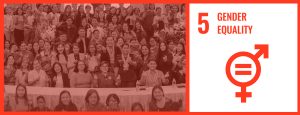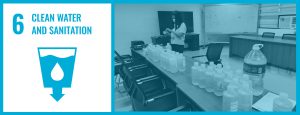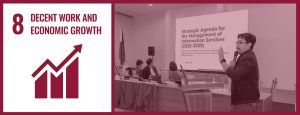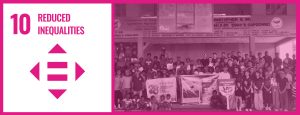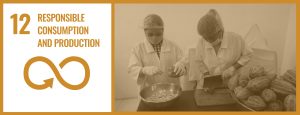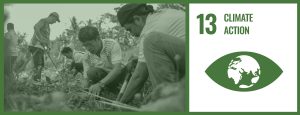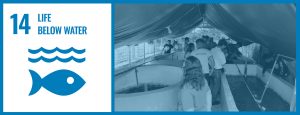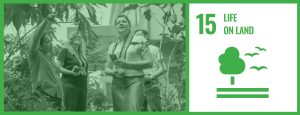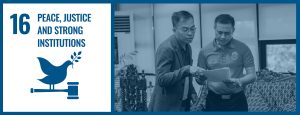2024 Research | SDG 17 – Partnerships for the Goals
Research Programs
Project: Upscaling of Postharvest Processing and Shelf-Life of Oyster Mushroom Study: Processing of Mushroom Loaf
Proponents: Melody E. Lim, Arlene I. Remigio, Ma. Leonila Cabaccan
Abstract
This study aims to evaluate the acceptability of mushrooms as a meat substitute in loaf and siomai. The products were assessed based on appearance, flavor, texture, aroma, and overall acceptability, and a cost-return analysis was conducted for each treatment. Data were analyzed using a Randomized Complete Block Design (RCBD). Results revealed that the experimental treatments using pure mushrooms demonstrated comparable attributes – appearance, flavor, texture, aroma, and general acceptability – to the control group, with the 30 panelists rating them as “like very much”. However, the aroma of loaf made with varying proportions of mushrooms was not comparable to the control, receiving a “like moderately” rating. The highest net income was achieved in the pure mushroom treatment (T4), which the panelists rated as “likely slight”.
Project: Upscaling of Postharvest Processing and Shelf-Life of Oyster Mushroom Study: Processing of Mushroom Steamed Dumpling
Proponents: Melody E. Lim, Arlene I. Remigio, Ma. Leonila Cabaccan
Abstract
This study presents the results of a sensory evaluation conducted to assess the attributes of oyster mushroom gyoza, with participation from 50 evaluators. The gyoza were evaluated based on five sensory attributes: appearance, aroma, texture, taste/flavor, and general acceptability, using a 1-9 hedonic scale where 1 indicates ‘dislike extremely.” The results demonstrated that the gyoza had a mean appearance score of 7.6, indicating favorable visual appeal. Aroma received a mean score of 7.2, suggesting general appreciation but less impact on the overall experience. The texture was highly rated with a mean of 7.8, showcasing a successful combination of the soft wrapper and tender filling. The taste/flavor emerged as the standout attribute, achieving a mean score of 8.3, reflecting strong satisfaction attributed to the umami-rich filling of the oyster mushrooms. The overall acceptability score of 8.0 confirmed that the gyoza were well-liked by the evaluators. The findings highlight the strong visual appeal, favorable texture, and particularly satisfying flavor of the oyster mushroom gyoza, establishing them as a successful plant-based alternative to traditional meat-filled dumplings.
More than ISU CBAPA’s KSA? Designing Faculty Researchers’ Quality Professional Development Prospective Framework for Sustainable Improvement in Research Engagement Study:Knowledge of Institutional Research Ecosystem
Proponents: Ralliegh F. Vizcarra, Amie P. Bala, Jayson G. Gollayan, Mariflor M. Devibar
Abstract
This study investigates the factors influencing research engagement among faculty members at the College of Business, Accountancy, and Public Administration (CBAPA) at Isabela State University (ISU). It highlights the significance of faculty involvement in research for professional development and improved educational quality. Utilizing a mixed-methods approach, the research identifies critical knowledge areas necessary for effective research practices, including critical thinking, diverse methodologies, and grant writing skills. Participants reported limited awareness of institutional resources and funding opportunities, indicating a pressing need for enhanced communication and support. The findings reveal that only 28.4% of faculty were fully aware of available insitutional resources, underscoring gaps in knowledge that hinder research productivity. The study proposes a framework aimed at fostering a strong research culture within CBAPA, emphasizing the integration of teaching and research as essential for academic excellence. By addressing these gaps through targeted outreach and training initiatives, the instituions can empower faculty researchers to maximize their initiatives, the institution can empowe faculty researchers to maximize their potential, ultimately contributing to sustainable growth and enhanced academic standing.
More than ISU CBAPA’s KSA? Designing Faculty Researchers’ Quality Professional Development Prospective Framework for Sustainable Improvement in Research Engagement Study:Research Core Knowledge, Technical and Soft Skills
Proponents: Ralliegh F. Vizcarra, Rolly L. San Jose, Meryl Pearl L, Facun, Mariflor M. Devibar
Abstract
This study explores the critical need for a structured professional development (PD) framework aimed at enhancing the core knowledge, technical skills, and soft skills of faculty researchers at Isabela State University College of Business, Accountancy, and Public Administration (ISU CBAPA). Findings reveal that while faculty members possess moderate knowledge of research methods, significant gaps exist in areas such as data collection, ethical practices, data analysis techniques, and publishing strategies. The research emphasizes the importance of integrating both technical and soft skills in PD initiatives to foster a culture of research excellence. By employing a mixed-methods approach, including qualitative descriptive and thematic analysis, the study identifies key areas for improvement and proposes targeted training programs to enhance faculty competencies. Ultimately, investigating in comprehensive PD initiatives is esential for empowering faculty to conduct high-quality research and effectoivley disseminate their findings.This aligns with existing literature that underscores the positive impact of holistic faculty development on research engagement and productivity. The proposed framework aims to cultivate a stronger academic culture at ISU CBAPA, thereby enhancing the overall impact of scholarly contributions.
More than ISU CBAPA’s KSA? Designing Faculty Researchers’ Quality Professional Development Prospective Framework for Sustainable Improvement in Research Engagement Study:Attitudinal Traits, Institutional Supports & Challenges
Proponents: Ralliegh F. Vizcarra, Jessica C. Managuelod, Jeanette Gonzales
Abstract
This study explores the essential knowledge areas and professional developmenyt (PD) needs of faculty researchers at ISU CBAPA to enhance their research engagement and productivity. Five key themes emerged: critical thinking and diverse methodologies, proficiency in quantitative and qualitative analysis, effective communication and collaboration, continual learning, and grant writing skills. Additionally, the research highlights the importance of understanding the organizational research structure, funding opportunities, and fostering a supportive research culture. Findings indicate that while faculty exhibit moderate knowledge in research methods, gaps exist in areas such as data collection, ethical practices, and publishing processes. The results underscore the necessity for a comprehensive PD framework that includes targeted training sessions, mentorship opportunities, and resource accessibility to empower faculty researchers. By addressing theses gaps, ISU CBAPA can cultivate a more robust research environment that promotes collaboration, innovation, and effective dissemination of research findings.
Closer Look to Explore the Knowledge, Skills & Attitudes (KSA) on the Faculty Community Engagement of the College of Business, Accountancy & Public Administration (CBAPA) Isabela State University Echague, Isabela Study: Knowldege of Community Service
Proponents: Amie G. Bala, Ralliegh F. Vizcarra, Jayson G. Gollayan, Vivian M. Dumrique
Abstract
This study develops a framework for assessing community service knowledge among faculty extensionists in the College of Business, Accountancy & Public Administration (CBAPA) at Isabela State University. Recognizing the critical role of community service in higher education, the research identifies gaps in faculty engagement and effectiveness, exacerbated by a disconnect between theoretical knowledge and practical application. The study employs a mixed-methods approach to explore the current level of knowledge among faculty regarding community needs, environmental awareness, and effective extension practices. key objectives include defininf essential knowledge components and assessing personal perspectives on community service initiatives. Findings reveal that faculty often struggle with understanding local cultural dynamics, which impedes their effectiveness. the study recommends targeted training programs and structural support to enhance faculty engagement in community service. The developed framework aims to foster sustained community partnerships, ensuring faculty are equipped to meet evolving community needs. This approach is vital for promoting deeper commitment to community engagement within academic institutions, ultimately contributing to the development of responsive community service initiatives.
Closer Look to Explore the Knowledge, Skills & Attitudes (KSA) on the Faculty Community Engagement of the College of Business, Accountancy & Public Administration (CBAPA) Isabela State University Echague, Isabela Study: Core and Soft Skills
Proponents: Amie G. Bala, Ralliegh F. Vizcarra, Exequiel M. Perez, Rolly L. San Jose
Abstract
This study explores the role of core and soft skills in enhancing the community engagement of faculty members at the College of Business, Accountancy, and Public Administration (CBAPA) at Isabela State University. Faculty involvement in extension activities is crucial in bridging academic knowledge and local community needs. However, there is a gap in understanding the competencies that contribute to impactful community engagements. This research evaluates the proficiency of CBAPA faculty in critical knowldege areas such as communication outreach. Utilizing a mixed-method approach, the study assesses the faculty’s motivation, collaboration efforts, and institutional support to develop a conceptual framework aimed at fostering sustained and meaningful community involvement. Findings suggest that while faculty members demonstrate strong communication and collaboration skills, there is room for improvement in technological proficiency and problem-solving. The study underscores the need for targeted faculty development programs to enhance both core and soft skills, thereby promoting a more structured and effective approach to community engagement. The outcomes provide insights into designing professional development initiatives that align faculty competencies with the demands of community extension activities.
Closer Look to Explore the Knowledge, Skills & Attitudes (KSA) on the Faculty Community Engagement of the College of Business, Accountancy & Public Administration (CBAPA) Isabela State University Echague, Isabela Study: Attitudinal Traits, Challenges and Supports
Proponents: Amie G. Bala, Leah B. Bitao, Norvelyn B. Bautista, Mariflor M. Devibar
Abstract
Community engagement is a critical aspect of higher education, facilitating the connection between acadmeic institutions and their surrounding communities. This studyaims to develop a comprehensive framework that examines the attitudinal traits, challenges, and support systems influencing the effectivess of faculty extensionists at the College of Business, Accountancy, and Public Administration (CBAPA) of Isabela State University. Key Attitudinal traits such as adaptability, collaboration, and accountability were explored alongside challenges like resource limitations, bureaucratic barriers, and post-pandemic restrictions. The study utilized a mixed-method approach, inciporating structured questionnaires and thematic analysis to assess faculty experiences and the support mehanisms available for community engagement. Results highlight the importance of internal and external linkages, as well as institutional support in enhancing faculty efforts. By identfying the traits, challenges, and supprt systems that shape faculty extensionists’ experiences, thi research provides valuable insights into improving community engagement practices within academic settings.
Mobile Solar Generator: A Disaster Resilient Power Source
Proponent: ROMEL B. CRISTOBAL
Abstract
The Mobile Solar Generator (MSG) was created to offer a backup source of electricity for homes, businesses, and schools, particularly during power outages caused by natural disasters. It makes use of both solar power technology and the concept of an ordinary AC generator. The MSG was developed using an old coaster (minibus) with four units of 330-watt monocrystalline photovoltaic (PV) panels mounted on its roof. Additionally, two units of 250 ampere-hour 12-volt gel-type deep cycle batteries, a 3-kilowatt inverter, a 40-ampere solar charge controller, and accessories were installed inside the coaster to complete the system. This project implemented the Analysis, Design, Development, Implementation, and Evaluation (ADDIE) model. Performance testing focused on component voltage, battery voltage, charging current, charging capacity, and abnormality codes. The findings showed that charging is feasible between 7:00 AM and 5:00 PM and optimal between 8:30 AM and 3:30 PM during sunny weather. The charging capacity was best under SWOL conditions, with 210.5 ampere-hours. Discharging time was longer during sunny and cloudy weather, and discharging with load lasted longer in sunny conditions. The payback period for this system is estimated at twenty-five (25) months.
Solar-Powered Automobile Air-con System
Proponents: ROMEL B. CRISTOBAL, RICHARD P. ESCALANTE, OSCAR G. BANGAYAN, JOEMARIE V. JOVELLAR
Abstract
The Solar-Powered Automobile Air-con System (SPAAS) was created as a replacement for the original design of the Automobile Air-con System. The SPAAS was installed on an old coaster (minibus) with four units of 330-watt monocrystalline photovoltaic (PV) panels mounted on its roof. Additionally, a 3-kilowatt inverter, a 40-ampere solar charge controller, two units of 250 ampere-hour 12-volt gel-type deep cycle batteries, and a 1-hp split-type air conditioner were also installed inside the coaster to complete the system. This study addresses the growing need in the transportation sector for green and energy-efficient solutions. The technique lowers carbon emissions and eliminates the need for conventional fossil fuels by using solar radiation, which is abundant and free, to power a refrigeration cycle. To ensure effective energy conversion and storage, the proposed design combines photovoltaic panels, a battery storage system, and an optimized air-con unit. The system’s performance characteristics, energy efficiency, and economic viability are examined in this article as it investigates the system’s technological feasibility. Additionally, it discusses the potential environmental benefits and challenges associated with the widespread adoption of Solar-Powered Automobile Air-con Systems.
Development of Upgradable Solar-Hybrid Technologies for Disaster Response, Climate Change Adaptation and Mitigation
Proponents: Franklin A. Samonte, Warlito D. Antonio, Restituto C. Miguel
Abstract
This study evaluates the viability of a hybrid-powered irrigation system that integrates a monocrystalline photovoltaic (PV) module and the local electric utility to supply a submersible pump for agricultural applications. The performance characteristics of the PV module, considering its maximum power output and optimal operating voltage, demonstrate its capability to efficiently harness solar energy. The submersible pump, rated at 1 HP, effectively supports irrigation needs with a maximum flow rate of 0.32 m³/min and a maximum head of 15 meters. However, financial analyses reveal significant challenges. The break-even analysis indicates a recovery period of approximately 11.9 years, suggesting considerable investment risk. Additionally, the negative Net Present Value (NPV) over 15 and 20 years highlights that projected costs exceed expected benefits, rendering the project financially unviable. The Benefit-Cost (B/C) ratio of less than 1 emphasizes that the costs outweigh the benefits, yielding only 0.53 to 0.59 PHP for every peso spent. This study concludes that while the hybrid system offers technical advantages, the current financial framework necessitates reassessment and strategic adjustments to enhance economic sustainability and encourage adoption among farmers. Recommendations include exploring financial incentives, optimizing operational efficiencies, and investing in farmer education.
“Innovative Approaches to Processed Meat Production: Improving Quality, Safety, and Sustainability”
Proponent: Mary Grace C. Buraga
Abstract
The study addresses the growing consumer awareness and negative perceptions surrounding processed foods by innovating healthier and more acceptable alternatives using locally sourced ingredients. Conducted in response to findings by the International Food Information Council, which indicated that 43% of primary grocery shoppers view processed foods unfavorably, this research focuses on developing innovative processed meats. Using banana stem as a natural flavor enhancer for longganisa and substituting traditional ingredients in tocino with pineapple wine and calamansi extract, the study employs a descriptive-experimental method to evaluate product acceptability. Respondents, including food and service management faculty, community members, and food producers, assessed the products based on appearance, color, aroma, taste, and texture using a seven-point Hedonic rating scale. The analysis, using weighted mean, aims to identify nutritional content and determine shelf life. Results show that the acceptability of innovative processed meats, specifically tocino and longganisa, using locally sourced ingredients to address consumer concerns about processed foods, is well-received by consumers. The sensory attributes of appearance, color, aroma, taste, and texture were assessed by three groups: FSM students, food experts, and community members. Tocino was highly rated across all sensory criteria, with community members giving the highest overall acceptability score (Grand Weighted Mean = 6.20). Longganisa also received positive ratings, particularly from FSM students (Grand Weighted Mean = 6.03), although food experts rated its appearance and texture as slightly acceptable. The study demonstrates that both tocino and longganisa are well-received by consumers, with potential for market success. The findings highlight the importance of natural flavor enhancements and minimal processing in meeting consumer expectations for healthier processed food options. This approach not only offers a sustainable model for food innovation but also supports local economies through the use of indigenous raw materials.
Acceptability of Slender Amaranth, Lemon Grass and Philippine lime as mixed juice drink
Proponent: Honelyn D. Farala
Abstract
This study evaluates the acceptability of three juice drinks formulated from slender amaranth, lemongrass, and Philippine lime, focusing on sensory attributes such as appearance/color, aroma/odor, taste/flavor, and texture. Three different treatments were assessed by respondents using a 9-point hedonic scale. The results indicate high acceptability across all treatments, with mean scores ranging from 7.82 to 8.61, all falling within the “Like Very Much” category. Treatment 3 emerged as the most preferred formulation, achieving the highest mean scores for appearance/color (M = 8.46), aroma/odor (M = 8.44), and texture (M = 8.61). One-way ANOVA revealed significant differences in taste/flavor (F = 5.830, p = 0.004) and texture (F = 4.254, p = 0.016), favoring Treatments 2 and 3 over Treatment 1. Post hoc analysis using Tukey’s multiple comparison test confirmed these differences, with Treatment 1 rated significantly lower in taste and texture compared to Treatments 2 and 3. The findings suggest that specific mixture ratios enhance sensory properties, particularly for Treatments 2 and 3. The high acceptability ratings indicate strong potential for these formulations as commercially viable products. Treatment 3 should be prioritized for further refinement and promotion as a premium offering within the market. The study provides valuable insights for product development and marketing strategies aimed at enhancing the appeal of functional beverages, ultimately contributing to their success in a competitive market.
School Need Assessment of Angadanan, Isabela: Key for Gender Responsive Extension Program
Proponents: EUGELYN R. FELIX, JUDITH E. DARACAN, PAULINO V. DERILO
Abstract
The study employed a descriptive design using a quantitative approach to assess the training needs of secondary school faculty members in Angadanan, Isabela, Philippines. The respondents included male and female faculty, non-teaching staff, and students from secondary schools in the municipality, selected through purposive sampling. A self-made survey questionnaire was used to gather data on the personal information, training experiences, and training needs of the respondents. The questionnaire also included a 5-point Likert scale to assess the degree of knowledge and skills of both student and teacher respondents. The data analysis involved frequency and percentage distribution to determine the distribution of responses for each item in the questionnaire, providing insights into the training experiences, knowledge, skills, and needs of the secondary school faculty. Descriptive statistics, including mean and standard deviation, were used to assess the degree of knowledge or skills of the respondents. The study found that the majority of the faculty members are relatively young, with 75.6% falling within the age brackets of 21–40 years. The faculty members have advanced levels of communication, interpersonal, and pedagogical skills, but their ICT, leadership, technological, research writing and publication, entrepreneurship, mental health, and gender and development-related skills are at an intermediate level. The most pressing needs among the faculty respondents are research writing and publication, ICT skills, and pedagogical skills. The majority of the student respondents are within the 11–15 years old age range, and the study suggests that the secondary schools in the municipality have a larger population of younger students compared to older students and a larger population of female students compared to male students. The study highlights the importance of addressing the diverse range of special needs among both students and faculty members through targeted interventions and support. The findings provide valuable insights that can inform the development of training programs and extension initiatives to enhance the skills and knowledge of the secondary school faculty and students.
Ybanag Traditional Cuisine: Basis for the Development of a Menu Guide
Proponent: DR. JOSEPHINE LUBO
Abstract
The Ybanag people represent one of the indigenous groups in Isabela, Philippines, alongside the Yogads, Itawes, and Gaddangs. Apart from these tribes, the Cagayan Valley region is home to various others, each with its own distinct language, including the Itawis, Irrayas, Gaddangs, Yogads, Ilongots, Negritos, and Igorots. The Ybanags predominantly inhabit the northern coastal towns of Pamplona, Claveria, Abulug, Appari, and Buguey, as well as Camalaniugan, Lallo, and Gattaran in the province of Cagayan. Additionally, they can be found in the towns of Cabagan, San Pablo, Sta. Maria, Tumauini, Ilagan, Gamu, and certain areas in Sto. Tomas, San Mariano, Angadanan, and Reina Mercedes within the province of Isabela.
This study aimed to document the indigenous foods of the Ybanags, which are gradually disappearing due to modernization and enculturation. As these foods fade away, so do the associated meanings, beliefs, and practices attached to them. By understanding their indigenous foods, we can bridge the gap between the Ybanags’ past generations and the present.
The study employed a mixed-method approach, combining descriptive-quantitative research methods. It involved 108 Ybanags, including 36 cooks, 18 restaurant owners, 24 tourism staff, and 30 indigenous people. Data collection utilized survey questionnaires and documentation. The foods were documented, and the elders provided insights into the health and social meanings and beliefs associated with these foods. Frequency and percentages were analyzed.
The findings revealed several native foods of the Ybanags, including Pancit Cabagan (Pansi), Binallay, Inatata (Bala-bala), Bebengka (Bibingkang Kanin), Nilupra (Inupra), Dinengdeng (Zinendeng), Pinataro, and corn coffee. The social life and physical health of the Ybanags have long been intertwined with their traditional foods. However, many of these foods and practices are increasingly threatened by the influences of modernization and development, posing a serious risk to their traditional culture and heritage.
Empowering Communities: Design,Fabrication, and Evaluation of Mobile Solar-Powered Charging Stations with Integrated Street Lighting and Automated Water Refilling Station for Disaster Resilience
Proponents: Jolan Baccay Sy, Jake La Madrid, Allen M. Paz
Abstract
This study investigates the design, fabrication, and evaluation of mobile solar-powered charging stations integrated with street lighting and automated water refilling systems, aimed at enhancing disaster resilience in rural communities, particularly at the Cabagan Riverside Evacuation Center. The primary objectives were to address energy and water accessibility challenges during natural disasters, develop functional designs for diverse community needs, and utilize sustainable materials for durability.
The innovative approach combines solar-powered charging, street lighting, and automated water refilling into a single mobile unit. Engineered to provide essential energy, lighting, and water access for one week in disaster-affected areas, the station features a lightweight frame, high-efficiency solar panels (330 watts), and a 100Ah battery. Multiple USB ports facilitate device charging, while integrated LED lighting enhances nighttime safety. The automated water refilling system employs ultrasonic sensors and an Arduino microcontroller for efficient water dispensing.
Evaluation through a structured questionnaire revealed significant improvements in energy access and safety, with high satisfaction among community members. This study underscores the potential of solar-powered solutions to strengthen disaster resilience and promote sustainability in vulnerable regions, offering valuable insights for policymakers and practitioners in disaster management.
Soil Quality Assessment in Masipi East, Cabagan, Isabela, Philippines: An Input for S&T Based Gmelina (Gmelina arborea Roxb.) Plantation Establishment
Proponents: Emerson V. Barcellano, Bondee L. Peñaflor, Rocel S. Galicia, Adona Joana S. Urmeneta
Abstract
Soil analysis provides information necessary to set nutrient application targets and allow monitoring and detection of changes in soil parameters over time. This study aimed to determine the quality of soil in the farmlands of upland communities in Cabagan, Isabela. Soil samples derived from pre-identified sites were collected following standard procedures, and the analysis was conducted at the laboratory of the Department of Agriculture.
Results show that the average pH of the 15 sites was 5.46, which is moderately acidic. In terms of the concentration of organic matter (%N), the lowest (0.96) was recorded at Plot #5, while the highest (2.30) was recorded at Plot #1. The average O.M. % (N) was 1.76, which is also classified under a moderate level. As to the phosphorus concentration (ppm), the lowest (2.8) was recorded at Plot #1, while the highest (14.4) was recorded at Plot #6, with an average concentration of 9.59 ppm, which is classified as low in terms of soil requirements for an effective and efficient crop production system. The lowest recorded level of potassium concentration was at Plot #2, while the highest was at Plot #8, with a mean concentration of 184 ppm, classified as moderate. On the other hand, these sites are classified as low in terms of zinc concentration, with 0.04 ppm at Plot #4 and 0.48 ppm (the highest) at Plot #8, and a mean concentration of 0.17 ppm.
The findings necessitate the need to: document the actual production of local farmers and estimate the profitability of their existing production operations; implement interventions to inform local farmers of the analysis results and identify appropriate technical approaches to be introduced; and ensure compliance with the recommendations of DA-CVIAL in terms of fertilizer applications and suitable crops to be planted.
Keywords: Soil, Soil Quality, Soil Quality Assessment, Database
Disaster Vulnerability, Preparedness and Resilience of Selected Flood-Prone Barangays in Isabela: Towards Actionable Risk Communication Intervention
Proponents: Rosalinda S. Guingab, Myrna C. Cureg, Regina Blair S. Santiago, Rico Martin V. Dumale
Abstract
Disasters, such as flooding, are becoming increasingly frequent and costly. This research study aimed to determine the disaster vulnerability, preparedness, and resilience of households in the most flood-prone barangays in three municipalities in Isabela. A descriptive quantitative research design guided the conduct of this study, using a pretested and reliability-tested survey questionnaire as the research instrument. Simple random sampling was used to select 140 respondents residing in the three barangays.
Indicators of preparedness and resilience reveal that the respondents were ill-prepared for flooding, with most of them living in one-storey houses made of lightweight materials. Inadequate proactive actions, such as lack of savings to cover emergency needs and lack of a regular source of income—both indicators of poor preparedness—compromise their resiliency and increase their vulnerability to the effects of flooding.
It appears that the respondents face challenges in absorbing financial losses should they experience extensive damage due to flooding. There is a need to further enhance the households’ disaster preparedness and resiliency. As an actionable risk communication intervention, developed IEC materials will be turned over to the MDRRMO of the three municipalities to be used during disaster capability-building programs to strengthen community preparedness and resilience.
Anti-Bullying Projects and Activities: Basis for Program Development
Proponent: Rosalie C. Leal
Abstract
Bullying in educational institutions is a pervasive issue of global significance, which poses detrimental effects on the overall atmosphere within schools and compromises the establishment of a secure and fear-free environment (Tambawal, 2014). The issue of violence is consistently intertwined with educational settings, prompting the Education department to place greater emphasis on the objective of cultivating violence-free schools. Consequently, students, parents, and instructors are being encouraged to actively combat any instances of violence that may arise within school environments (Dahisgaard, 2013).
According to a recently performed poll, it was shown that almost 50% of Filipino children are exposed to incidents of violence or abuse within the educational setting. According to Baranta (2015), the Department of Education in the Philippines documented a total of over 1,700 incidents of child abuse or bullying within schools during the years 2013 and 2014, despite the implementation of the Child Protection Policy by DepEd across the nation.
Given this issue, the researcher made the decision to conduct an investigation into the scope of bullying within the district and its impact on the academic achievement of elementary school students. The primary objective of this study is to gather data that can be utilized by students, educators, parents, and relevant stakeholders in order to construct interventions aimed at addressing the prevalence of bullying. Additionally, the study aims to identify techniques that can enhance the academic performance of students. Therefore, this investigation was undertaken.
Mathematical Creative Thinking Ability in Solving Open-Ended Problems
Proponents: Jestoni Castillo, Dr. Liezl Joy L. Quilang
Abstract
Creative thinking is essential for students in learning mathematics, yet previous studies indicate that many students struggle to develop this skill. This research aimed to evaluate mathematical creative thinking in junior high school students, specifically focusing on fluency, flexibility, and originality in solving open-ended problems. A mixed-method approach was employed, involving thirty-four students from a national high school. Data were collected through an open-ended problem-solving test and semi-structured interviews, analyzed using frequencies and percentages, and content analysis was employed to categorize responses.
Findings revealed that students demonstrated a moderate level of creative thinking in fluency, flexibility, and elaboration. On average, students provided two correct answers and employed various strategies; however, some struggled with appropriate mathematical concepts and terminology. Originality, however, was notably low, with few students offering unique solutions, leading to nearly uniform responses across the group.
These results suggest that students have not yet fully realized their creative potential, particularly in originality. The study concludes that exposing students to diverse open-ended problems can enhance their mathematical creative thinking abilities, fostering greater fluency, flexibility, and originality in problem-solving.
Gastronomic Heritage Awareness: The Knowledge of BS Hospitality Management Students of ISU-Cauayan Campus on the Culinary Traditions in Kakanin-Making of Isabela
Proponent: Dr. Karla Jastine C. Maramag
Abstract
The purpose of this study is to investigate the level of awareness among BS Hospitality Management students at ISU-Cauayan Campus regarding the culinary traditions of kakanin-making in Isabela, which are an important part of the province’s culinary heritage. The study aims to examine students’ understanding of the origins, names, taste, appearance, and traditional preparation methods of various kakanin products, as well as identify challenges in conserving these culinary practices.
A mixed-method approach was used in this study, and Hospitality Management students were randomly selected as participants. Data were collected through questionnaires and open-ended interviews, and students’ knowledge was analyzed based on key factors such as gender, year level, and length of residency.
Results show that participants are aware of the gastronomic heritage of kakanin products in the province in terms of their origin, names, taste, appearance, and culinary techniques and methods. The study also highlights several challenges, such as changing trends, loss of interest, the time-consuming preparation process, and the lack of traditional knowledge and equipment, which pose risks to the preservation of these culinary traditions.
The findings of this study can help enhance students’ awareness of gastronomic heritage by integrating it into the BSHM curriculum to address knowledge gaps in traditional preparation methods. Additionally, organizing cultural festivals and food fairs focused on kakanin can further showcase these culinary traditions. Using the internet to create accessible online resources about traditional kakanin-making will also support learning and encourage engagement with this essential aspect of culinary heritage.
Assessing the Food Service Industry Workforce Needs: The Employers’ Perspective on Technical and Management Competency and Employability of BSHM University Graduates
Proponent: Dr. Mildred V. Matulin
Abstract
The food service industry plays a crucial role in driving economic growth, where graduates of the Bachelor of Science in Hospitality Management (BSHM) program are required to adapt to changing competency standards. This study utilized a qualitative descriptive research design, collecting data through open-ended questions with food service employers in Cauayan City to assess their perspectives on the technical and managerial skills of BSHM graduates.
The findings indicate that employers place high value on qualities such as self-motivation, adaptability, and effective communication skills, all of which are crucial for thriving in a fast-paced work environment. Moreover, employers highlighted the importance of hands-on experience and a professional demeanor, suggesting that recent graduates should possess both technical knowledge and interpersonal abilities.
The results underscore the need for higher education institutions to align their curricula with industry requirements by incorporating practical training, refining communication skills, and deepening students’ understanding of career trajectories. This study concludes that addressing these skill gaps will significantly enhance the employability of BSHM graduates and better prepare them for the challenges of the food service industry.
Integration of Sustainable Goals into Teacher Education Curriculum: Insights from BEED and BSED 3rd Year Students
Proponent: Dr. Teresita C. Molano
Abstract
The main objective of this research was to explore the integration of Sustainable Development Goals (SDGs) into The Teacher and the School Curriculum course for 3rd-year BEED and BSEd students at Isabela State University, Cauayan Campus. Recognizing the vital role of educators in promoting sustainability, the study examined the current level of SDG awareness among 100 students through a needs analysis survey. An SDG-integrated curriculum was then designed, implemented, and evaluated for its impact on students’ knowledge and understanding using pretest and posttest assessments.
Results revealed that 83% of respondents were aware of the SDGs; however, only 45% felt ready to teach them, and 40% felt prepared to integrate them into classroom instruction. After the implementation of the integrated curriculum, students’ understanding improved significantly, with mean test scores increasing from 26/50 (52%) to 39/50 (78%). The t-value of 9.12 and p-value of 0.0001 confirmed that this improvement was statistically significant.
Interviews further showed an enhanced understanding of teachers’ roles in promoting sustainability, particularly concerning SDG 4 (Quality Education), SDG 5 (Gender Equality), and SDG 10 (Reduced Inequalities). The study concludes by proposing a cross-disciplinary pedagogical model for effectively integrating SDGs into teacher education and higher education programs.
Assessing the Critical Landscape of Mathematics Classroom
Proponent: Dr. Arnold T. Pascua
Abstract
This study employed a descriptive-comparative correlational research design to assess the critical thinking dispositions of high school students and examine their relationship with mathematics achievement. It summarized students’ critical thinking traits and mathematics scores, compared these traits across demographic variables such as age, sex, and daily allowance, and analyzed the relationship between critical thinking dispositions and academic performance in mathematics. The sample included 60 randomly selected Grade 8 students from the 2023–2024 school year. Research instruments consisted of a demographic profile questionnaire, the Critical Thinking Disposition Questionnaire (CTDQ), and a mathematics test validated by experts. Data were analyzed using descriptive statistics, t-tests, and Pearson correlation.
Findings revealed no significant differences in critical thinking dispositions based on sex and daily allowance, though a significant age-related difference was observed in critical thinking self-confidence and inquisitiveness. Similarly, mathematics achievement varied significantly by age but not by sex or daily allowance. Correlation analysis showed weak, non-significant relationships between most critical thinking traits and mathematics achievement, except for critical thinking self-confidence, which demonstrated a positive correlation with math performance. These results suggest that while critical thinking dispositions contribute to learning, their direct influence on mathematics achievement remains limited.
UAV-Based Corn Health Recognition Model Using Enhanced Threshold-Based Segmentation for Corn Plantation
Proponent: Dr. Joel M. Gumiran
Abstract
Phenotyping is essential for evaluating plant health traits, yet traditional methods can be tedious and labor-intensive, particularly when applied on a large scale. To address this, Unmanned Aerial Vehicles (UAVs) have been utilized for phenotyping due to their ease of use, high-resolution imaging, and cost-effectiveness. However, UAV-based phenotyping segmentation still encounters challenges that can hinder segmentation quality and reduce recognition accuracy. To overcome these limitations, this study implemented an Enhanced Threshold-Based Segmentation technique that normalizes image luminosity, improving both segmentation precision and recognition accuracy.
During the recognition phase, template matching was applied, achieving perfect correlation when the Normalized Cross-Correlation (NCC) equaled 1. After image normalization, recognition accuracy increased by 5.25%, attaining a high accuracy rate of 98.07% at a distance of 4 meters. These results demonstrate that the enhanced segmentation technique significantly improves the precision of unhealthy leaf identification. This advancement offers substantial benefits to farmers and agriculturists by reducing the time, effort, and costs involved in monitoring and managing crop health.
Designing and Construction of Posture Brace Integrating Backpack Functionality
Proponent: Ronald B. Isidro Jr
Abstract
This study presents the design and development of a posture-correcting brace integrated with backpack functionality, aimed at promoting proper spinal alignment and reducing the risk of back pain. The dual-purpose device serves both corrective and practical functions, making it ideal for students and professionals who frequently carry heavy loads. The design emphasizes ergonomic support by distributing weight evenly across the shoulders and back while encouraging correct posture. Prototyping and testing results demonstrate that the integrated posture brace and backpack provide notable ergonomic improvements compared to conventional backpack designs, offering a functional and health-supportive solution for everyday use.
Design and Production of Abdominal Brace Contraption Merged with the Function of Utility Apparel
Proponent: Ronald B. Isidro Jr
Abstract
This study focuses on the design and development of an abdominal brace integrated with utility apparel functionality, aiming to combine physical support with practical usability. The device is designed to provide abdominal stability while incorporating functional storage components for enhanced convenience, particularly for users engaged in physically demanding activities. The prototype was fabricated and evaluated for comfort, support, and usability. Results indicate that this hybrid design effectively merges health-related benefits with everyday practicality, demonstrating potential to improve both physical well-being and productivity in daily routines.


